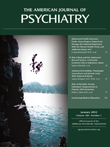Response to Boot et al. Letter
To the Editor: The report by Boot et al. (1) of three people diagnosed with schizophrenia and carrying isodicentric chromosome 15 (two maternally derived, the third of unknown parental origin) adds weight to the notion put forward in our previous article (2) that overexpression of maternally expressed genes in the Prader-Willi/Angelman syndrome region on chromosome 15 may be a risk factor for psychotic illness. It also prompts the intriguing question of whether subjects carrying three maternal copies of the imprinted 15q region suffer from a more severe and recurrent form of psychosis than do subjects with two copies, which is consistent with the gene-dosage effect suggested in our own article (2) and in a recent article on UBE3A dosage in mice (3) (although the latter measured the effect of UBE3A dosage on the severity of autism traits and not psychotic symptoms).
Boot and colleagues' observation of clozapine efficacy should, however, be interpreted with caution considering the small number of cases. In our article, we presented case reports in a supplement with information on treatment and response (2). The Danish patient received numerous antipsychotics, including clozapine, and the condition was nonetheless considered treatment refractory. The German patient also received numerous antipsychotics, although not clozapine, and also showed little response to treatment. We have little information on the treatment and response for one of the British patients (female), while the psychotic symptoms in the other patient (male) did not respond well to antipsychotics (no mention of clozapine). The psychotic symptoms responded to antipsychotics during the early course of illness in our Icelandic patients, but the symptoms subsequently responded even better to clozapine in the patient diagnosed with schizophrenia, and the manic and psychotic symptoms responded to lithium and antipsychotics in the patient diagnosed with bipolar I disorder.
All in all, it would be premature to conclude on the basis of our limited data that clozapine is more effective against psychotic symptoms in the 15q proximal duplication syndrome than in psychotic illness in general because of the small number of carriers and the lack of data on clozapine treatment. On the other hand, taken together with the report from Boot et al., our data could suggest that the psychotic symptoms in this syndrome may not respond well, as three of five subjects in our study responded poorly to antipsychotic treatment (data missing on the sixth subject) and all three cases from Boot et al. responded poorly to their initial antipsychotic treatment.
1. : Overexpression of chromosome 15q11-q13 gene products: a risk factor for schizophrenia and associated psychoses? (letter). Am J Psychiatry 2012; 169:96–97Link, Google Scholar
2. : Maternally derived microduplications at 15q11-q13: implication of imprinted genes in psychotic illness. Am J Psychiatry 2011; 168:408–417Link, Google Scholar
3. : Increased gene dosage of UBE3A results in autism traits and decreased glutamate synaptic transmission in mice. Sci Transl Med 2011; 3:103Crossref, Google Scholar



